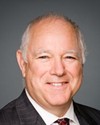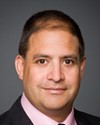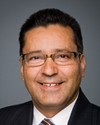Good afternoon.
I'd like to thank you for the opportunity to come here to speak to you about two very special programs we have for our war service veterans and other veterans across the department. Over the years we've been very privileged to be able to provide an array of services to Canada's war veterans.
The material you have before you has been provided in advance, so I won't be going over the details of the slides. You can ask me any questions afterwards, but I'll speak to the themes and highlights of those slides so we can get through them.
I'd like to begin with slide 3 and some key underpinnings of VAC's approach to what we call a continuum of care. VAC has been in the business of providing home care and long-term care for more than a quarter of a century now. We know that clients prefer to stay in their own homes in their own communities as long as possible. For many veterans, home care is the preferred and most cost-effective option we can provide them. It promotes client independence, and we try to offer a continuum of supports that promote choice and independence, while at the same time trying to be cost-effective.
Our services have evolved over a number of years. The VIP and long-term care programs have evolved significantly over the last quarter of a century. One of the things we try to pay most attention to in both programs is quality of care.
When we speak to a continuum of care, there are many definitions, but what we essentially refer to is an integrated and seamless system of services for veterans. Our approach is needs based, designed to foster a continuity of care using a variety of resources and providers we have and that exist in people's communities. It's designed to serve clients along their life courses from a needs-based approach, recognizing that people and circumstances change as they move through those life courses. It includes a variety of things such as health care benefits; medical services; supports to encourage and support independent living; and then intermediate, chronic, and residential care settings.
I'll take a few minutes to speak to you about the veterans independence program. Some of you may know about this program; others may not. The goal of the veterans independence program is to help people stay as healthy as possible, try to prevent functional decline, and remain independent in their own homes. It's available to eligible veterans, primary caregivers, and certain survivors of veterans who were never in receipt of VIP. It enables people to be independent and self-sufficient. It tries to improve their long-term health care by having services that are implemented as early as possible, improve quality of life for recipients and their families, and reduce the skyrocketing costs of institutionalization.
These outcomes are achieved through various benefits we have in the VIP. Some of the bigger ones are listed in your next two slides. Slide 8 really touches on the largest pieces of the VIP. The total expenditures for the program are $303 million. About 60% of that is focused on the housekeeping area. Nursing home care occupies about $54 million. Grounds maintenance is about $46 million. Then there are the smaller components of nutrition and personal care.
On the next slide we talk about the type of evaluation that has occurred with the VIP over the years. As far as we know and understand from our provincial partners, it is the longest-standing program with a national capacity in Canada. It provides clients requiring different types of care with the services that will delay their need for institutionalization.
We know it has been rated at a very high level by recipients, and as far as substitution of care, it reduces health care costs significantly. We also know--and you can see some of the numbers there--that the average cost of providing VIP for somebody in their house is about $2,800 a year. VAC's contribution to a VAC contract bed is on average annually $56,000 a year, and we contribute to the cost of care for veterans in community facilities about $13,000 a year.
We also know through various programs we have, such as the OSV/VIP, which is the overseas veterans at-home program, that when some veterans--and we've had a couple thousand of these--are offered services at home, many who were assessed as requiring long-term care and nursing home care are able to stay at home. In fact, they can stay at home for a long period of time and not require that institutional care. So we're very pleased with some of the results we've had with this program.
On the next slide, we introduce something called the continuing care research project. This was a large-scale study undertaken between VAC and the Government of Ontario. It was endorsed by the Canadian Seniors Partnership, and it recently released some major findings. Some of these are summarized on page 11: “Under appropriate circumstances, long-term home care is often a cost-effective alternative to long-term facility care. With this study, there is now a substantial weight of research evidence that home care is a lower cost alternative to long-term facility care”--even for people at similar care levels--“even when the cost of informal caregiver time is considered.” In other words, it was factored in that if you paid for the informal caregiver time,plus the other services that were being received at home, the home care services were still a much more cost-effective alternative and a much preferred alternative to facility-based care.
We also note through this study that “Home support services are an integral part of long-term home care. Veterans Affairs Canada has data to suggest that its Veterans Independence Program is beneficial to Veterans, caregivers, and...taxpayers.” And we have “a growing body of evidence about the substantial economic contribution made by informal caregivers” across the country.
There is a tremendous amount of potential now to develop new knowledge from VAC's experience and through this research. The study has garnered a significant amount of interest in provincial forums, at the federal health care partnership level, and with other providers. Certainly, if this committee is interested in a more complete or comprehensive review of that study, it can be provided to you.
I'll take you to page 13 now and demonstrate some of the types of feedback we've been receiving from VIP.
VIP has been called the gold standard for home care in Canada by a variety of experts. It's been called the perfect model of independent senior care. It has been featured in Healthcare Quarterly, a Canadian publication geared to health care managers and administration. The feature in that particular magazine was entitled “Increasing Value for Money in the Canadian Healthcare System”.
VIP has been a key topic discussed at a number of different conferences and symposia focused on aging and seniors, including the Canadian Research Network for Care in the Community.
As you may know, the Special Senate Committee on Aging commends Veterans Affairs Canada on its success and cost-effectiveness in creating a program for veterans that is considered the gold standard across the country. In fact, the committee has identified VIP as a possible model for a national home care program.
We continue on an ongoing basis to meet with our partners in the provinces and in other jurisdictions to talk about the VIP program, its success, its challenges, how the program has evolved over the years, and the changes we're looking at making to ensure that it remains completely relevant to the clients it's trying to serve.
On slide 14, just to very quickly give you a sense in the graph of the VIP forecast, the top line represents the uptake of VIP since inception in 1981 and how it peaked once again with the introduction of the survivors becoming eligible for VIP, the expansion of VIP services to survivors in 2001. In 2002, you can start to see the increase there. It also shows you the clear demographic pattern that's existing, and that the need for VIP over the next decade will subside, will decrease. We see some uptake from the CF veterans, but certainly not enough to compensate for the decline in other populations.
I'll move on to the next slide to provide you with an overview of our long-term care program. It has a very long history. Long-term care in Veterans Affairs Canada started after the First World War. It was a program intended to support veterans coming back from war who had acute and rehabilitative needs. Veterans Affairs operated its own system of hospitals. In fact, in the mid-1940s, Veterans Affairs had 44 hospitals and facilities that we were operating across the country for veterans. Of course, the Veterans Affairs system predated universal health care in Canada, and there was a need to create a variety of different services as veterans evolved in terms of their needs. As they aged, the institutions began to change in terms of their focus from providing acute and rehabilitative care to more chronic and long-term care.
The facilities, with the exception for one—Ste. Anne's Hospital in Montreal—were transferred to the provinces beginning in the 1960s as a result of something called the Glassco commission and a cabinet decision to transfer those facilities to the provinces, which took on the jurisdiction and responsibility for health care across the country.
We continue to evolve in the long-term care program. There are changes being made to try to be relevant and adapt to the changing needs of veterans as we move through the system. Their current program includes just over 10,000 clients, with just over 3,000 clients in what we call our contract beds, and 7,000 clients in community beds, which are also known as provincial beds.
The long-term care program supports three different types of beds: contract beds, which are beds either in community facilities or in large veterans facilities with which Veterans Affairs has a contractual arrangement to provide care for veterans in those beds; departmental beds, which refer to the 420-odd beds we have at Ste. Anne's Hospital; and then the majority of clients reside in community beds, which are provincial beds that are available to them as citizens of their province, and Veterans Affairs helps them with their cost of care.
We operate within the provincial systems across the board, and we try to ensure there's fairness and consistency with respect to the amount that a veteran will pay in a bed, regardless of where they live. If a veteran lives in a province that does not insure long-term care, they will pay the same rate as a veteran who lives in a province that does insure long-term care. In the Atlantic provinces, in Nova Scotia and Prince Edward Island, Veterans Affairs will pay more because the cost to the resident is more. The veteran will pay $856 in British Columbia. We will pay less, and the province picks up more, and the veteran will pay $856.
On page 17 you can see that today we have just over 100,000 VIP clients, with 96,000 in the community and 7,000 in long-term care. We have just over 3,500 long-term care clients who are not VIP clients. That means those clients are in contract beds. The forecast for just under a decade from now sees that 103,000 drop to just over half, to 65,000, and the long-term care number to about the same, about 50% of today's number.
The next slide gives you a sense of the long-term care forecast. We believe we have peaked in terms of the long-term care admissions for veterans--which are around 10,500 or so--and that we're now on the downside of the slope. Those numbers should decrease slightly over the next few years, and in about three to four years they should decrease quite dramatically.
The next slide is slide 19.
We operate our long-term care program in a complex system of provinces, health authorities, health boards, and so on. The program continues to evolve in order to try to meet veterans' needs across all these various jurisdictions.
Client choice is a key factor for our long-term care program. Veterans have been voting with their feet. Over the last decade, we've seen an increase of 80% in terms of community bed uptake, and although our contract beds have been available to veterans, we've actually seen a decrease while the overall numbers have continued to increase.
Implementing quality assurance in our long-term care program is our number one priority. We understand that our veterans live in a variety of facilities, most of them facilities that we neither own nor operate, and over which we have no jurisdiction. Finding ways to ensure that veterans are okay, that we meet the commitment we made to these people many years ago, is the number one priority in this program. We examine how best to recognize and support them in their choices in where they want to live, whether they want to continue to live at home, in an alternative setting in their community, or in long-term care.
We have a contingent of contract beds, as you know. We're beginning to experience vacancies across those contract beds, and we're beginning to make plans to ensure that the contract beds of the future remain there for the veterans who need them. Many of them are specialized. We want to be able to use those assets to provide the specialized type of care that veterans may not be able to receive in their community in a timely manner.
Contract beds serve as a tremendous asset to us. If a veteran doesn't need a contract bed as a traditional long-term care bed, they may in fact need specialized care that we might be able to provide through that bed. We work with provinces and health authorities to ensure that if veterans do not need the contract beds we have to pay for, those beds may be available for use in the community. We continue to ensure that we have the highest standard possible for our departmental beds in our Ste. Anne's facility.
When we speak of war service veterans, we are keenly aware that we have a responsibility to ensure that Canada's deep commitment to these very special people is met and that we provide them with the programs, services, and support that we insisted we would provide to them in the years to come.
This is very important for those of us who, as I have, have worked with veterans for a long time in long-term care. I visited them in their homes when I first started with Veterans Affairs. These are very special people. Time is the enemy for them. There is only a certain amount of time, and we need to make sure these folks have services and programs across the board, whether in community facilities or in contract facilities; that we're engaged in a variety of activities with other providers to ensure that their needs are fully met; and that they can exercise their independence and their choice.
We try to manage the VIP and long-term care as a continuum for the benefit of veterans. We have brought these programs together under one operational unit to ensure that when we look at changes in the VIP, they mesh and merge with the long-term care program so that we eliminate any gaps that may exist between those two programs and we strengthen the continuity between them. We need to ensure that the evolving provincial programs we see every day are captured in this continuum of support.
Every day something changes across the provinces, across the health authorities, and it's our responsibility to ensure that within the limits of our authorities, we find ways to support veterans through all these different and evolving types of care. We must eliminate gaps and overlaps between the programs so that they can be supported through one or the other and not fall in between them. Within our current authorities we will advance, and are advancing, policy solutions that allow for options to be found to solve both some of the problems we ourselves are facing and some of the problems across the provinces in which veterans live.
I want to talk a little bit about quality of care.
Quality assurance is key to us. We know that most of our veterans live in provincial beds--those who are in long-term care--in systems that are strained, in circumstances that are sometimes volatile. We lack jurisdictional authority. We work with our partners to help make improvements; however, at the end of the day, what we can do is ensure that our individual veterans in long-term care, those who have moved to a place that will likely be the last place they live in their lives, are okay.
We've undertaken some very aggressive initiatives to ensure that this happens. We, in partnership with the Royal Canadian Legion, are visiting and undertaking satisfaction questionnaires with up to 4,000 veterans a year across all sorts of different facilities.
We have recently begun a process under which we will send out a registered nurse to visit up to 4,000 veterans a year to ensure that their needs are being met, regardless of whether they live in a licensed, regulated community facility or not. We know that things can slip by and that nothing can replace the presence of a health professional who is able to undertake a comprehensive assessment and identify unmet needs so that we can take appropriate action.
We undertake facility reviews on a variety of facilities, whether they're veterans' facilities or not, and in most cases they're not. We're also pursuing, in partnership with Accreditation Canada, an expanded accreditation program that will see accreditation exist not only for the larger facilities but also for the smaller ones in rural communities and in smaller communities where we know veterans live.
We will continue to monitor provincial compliance measures. Provinces, to varying degrees, undertake different kinds of processes aimed at ensuring that their facilities are meeting the long-term care standards of that province. We have a process in place where we monitor the various compliance measures, we identify when facilities have not met various standards, and then we undertake action in that regard, undertaking a facility review and other action as deemed appropriate.
With respect to the veterans independence program, we undertake monthly file reviews at the field level, at our district offices. We do annual follow-ups on clients. We do audits and evaluations of registered providers who are providing services to veterans, and we undertake quality assurance reviews on a targeted basis.
I'll now give you a break from me and pass you over to my colleague Colleen Soltermann, who'll talk to you about our treatment benefits program.












